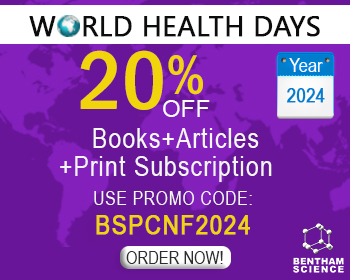Abstract
Fragment-Based Drug Design (FBDD) has established itself as a promising approach in modern drug discovery, accelerating and improving lead optimization, while playing a crucial role in diminishing the high attrition rates at all stages in the drug development process. On the other hand, FBDD has benefited from the application of computational methodologies, where the models derived from the Quantitative Structure-Activity Relationships (QSAR) have become consolidated tools. This mini-review focuses on the evolution and main applications of the QSAR paradigm in the context of FBDD in the last five years. This report places particular emphasis on the QSAR models derived from fragment-based topological approaches to extract physicochemical and/or structural information, allowing to design potentially novel mono- or multi-target inhibitors from relatively large and heterogeneous databases. Here, we also discuss the need to apply multi-scale modeling, to exemplify how different datasets based on target inhibition can be simultaneously integrated and predicted together with other relevant endpoints such as the biological activity against non-biomolecular targets, as well as in vitro and in vivo toxicity and pharmacokinetic properties. In this context, seminal papers are briefly analyzed. As huge amounts of data continue to accumulate in the domains of the chemical, biological and biomedical sciences, it has become clear that drug discovery must be viewed as a multi-scale optimization process. An ideal multi-scale approach should integrate diverse chemical and biological data and also serve as a knowledge generator, enabling the design of potentially optimal chemicals that may become therapeutic agents.
Keywords: Artificial neural network, docking, FBDD, molecular fragment, multi-scale model, pseudo-linear equation, QSAR.
[http://dx.doi.org/10.1002/9780470721551]
[http://dx.doi.org/10.1038/nrd.2016.109] [PMID: 27417849]
[http://dx.doi.org/10.1038/nrd.2016.123] [PMID: 27516170]
[http://dx.doi.org/10.1021/acs.jmedchem.6b01123] [PMID: 27739691]
[http://dx.doi.org/10.1002/3527608761]
[http://dx.doi.org/10.1016/j.jhealeco.2016.01.012] [PMID: 26928437]
[http://dx.doi.org/10.1042/EBC20170028] [PMID: 29118093]
[http://dx.doi.org/10.1016/j.ejmech.2018.10.050] [PMID: 30388464]
[http://dx.doi.org/10.1016/j.jmgm.2018.09.014] [PMID: 30415122]
[http://dx.doi.org/10.1016/j.jmgm.2018.07.007] [PMID: 30149308]
[http://dx.doi.org/10.1208/s12248-017-0093-5] [PMID: 28560482]
[http://dx.doi.org/10.1021/acs.jcim.7b00690] [PMID: 29762023]
[http://dx.doi.org/10.1021/acscentsci.7b00572] [PMID: 29532027]
[http://dx.doi.org/10.1021/acscentsci.7b00512] [PMID: 29392184]
[http://dx.doi.org/10.1021/acs.molpharmaceut.7b00346] [PMID: 28703000]
[PMID: 834185]
[http://dx.doi.org/10.1016/j.bmc.2010.01.068] [PMID: 20185316]
[http://dx.doi.org/10.2174/092986712799945058] [PMID: 22376033]
[http://dx.doi.org/10.2174/138955712800493744] [PMID: 22587771]
[http://dx.doi.org/10.1002/9783527613106]
[http://dx.doi.org/10.1002/9783527615452]
[http://dx.doi.org/10.1016/j.drudis.2018.05.010] [PMID: 29750902]
[http://dx.doi.org/10.1039/9781847558879-00001]
[http://dx.doi.org/10.1016/j.bpj.2018.02.038] [PMID: 29606412]
[http://dx.doi.org/10.1111/cbdd.13110] [PMID: 28944571]
[http://dx.doi.org/10.1080/17460441.2016.1190706] [PMID: 27186904]
[http://dx.doi.org/10.1517/17460441.2015.1078308] [PMID: 26313123]
[http://dx.doi.org/10.1080/17460441.2018.1403419] [PMID: 29139324]
[http://dx.doi.org/10.1016/j.drudis.2016.11.001] [PMID: 27890821]
[http://dx.doi.org/10.4155/fmc.16.9] [PMID: 27054816]
[http://dx.doi.org/10.2174/156802611796391276] [PMID: 21470171]
[http://dx.doi.org/10.1517/17460441.2016.1135126] [PMID: 26689499]
[http://dx.doi.org/10.2174/1381612822666160224142323] [PMID: 26907944]
[http://dx.doi.org/10.1039/C8NJ01034J]
[http://dx.doi.org/10.1080/1062936X.2018.1529702] [PMID: 30332922]
[http://dx.doi.org/10.1080/07391102.2016.1252282] [PMID: 27809673]
[http://dx.doi.org/10.1111/cbdd.12290] [PMID: 24447365]
[http://dx.doi.org/10.1186/s12859-016-1379-9] [PMID: 28155653]
[http://dx.doi.org/10.1080/07391102.2015.1113386] [PMID: 26510381]
[http://dx.doi.org/10.1155/2014/979606] [PMID: 25019089]
[PMID: 28058055]
[http://dx.doi.org/10.1016/j.jmgm.2014.04.015] [PMID: 24858256]
[http://dx.doi.org/10.1007/s11030-015-9617-z] [PMID: 26205409]
[http://dx.doi.org/10.1016/S0014-2999(96)00901-6] [PMID: 9059860]
[http://dx.doi.org/10.1152/ajpgi.00454.2007] [PMID: 18063703]
[http://dx.doi.org/10.1124/jpet.107.127480] [PMID: 17906066]
[http://dx.doi.org/10.1158/1078-0432.CCR-03-0651] [PMID: 15240539]
[http://dx.doi.org/10.1021/ci0255331] [PMID: 12377009]
[http://dx.doi.org/10.1021/ci034039+] [PMID: 12870911]
[http://dx.doi.org/10.1021/ci0342425] [PMID: 15032551]
[http://dx.doi.org/10.1007/s11030-009-9129-9] [PMID: 19340599]
[http://dx.doi.org/10.1007/s10654-007-9204-4] [PMID: 18075776]
[http://dx.doi.org/10.18632/oncotarget.7459] [PMID: 26909596]
[http://dx.doi.org/10.1016/j.mayocp.2014.12.002] [PMID: 25744116]
[http://dx.doi.org/10.1038/nrc3599] [PMID: 24060863]
[http://dx.doi.org/10.1021/mp800102c] [PMID: 19281186]
[http://dx.doi.org/10.1021/pr101009e] [PMID: 21184613]
[http://dx.doi.org/10.1016/j.jtbi.2011.01.010] [PMID: 21277861]
[http://dx.doi.org/10.1016/j.ejmech.2011.01.023] [PMID: 21315497]
[http://dx.doi.org/10.2174/1568026611209061843] [PMID: 23030618]
[http://dx.doi.org/10.2174/157489311795222392]
[http://dx.doi.org/10.2174/138620712802650487] [PMID: 22452349]
[http://dx.doi.org/10.2174/1574893611308040007]
[http://dx.doi.org/10.1016/j.ejmech.2011.02.072] [PMID: 21447431]
[http://dx.doi.org/10.1007/s11030-011-9337-y] [PMID: 22020812]
[http://dx.doi.org/10.2174/1567205011310020001] [PMID: 22515494]
[http://dx.doi.org/10.1007/s11030-010-9280-3] [PMID: 20931280]
[http://dx.doi.org/10.2174/1568026611212240005] [PMID: 23368101]
[http://dx.doi.org/10.2174/138955712802762383] [PMID: 22420572]
[http://dx.doi.org/10.2174/1568026615666150506144814] [PMID: 25961517]
[http://dx.doi.org/10.1021/ci00025a021]
[http://dx.doi.org/10.1007/s11030-015-9571-9] [PMID: 25754075]
[http://dx.doi.org/10.1093/nar/gkr777] [PMID: 21948594]
[http://dx.doi.org/10.1021/ci049714+] [PMID: 15667143]
[http://dx.doi.org/10.1002/9781118026038.ch22]
[http://dx.doi.org/10.1016/S0169-409X(00)00129-0] [PMID: 11259830]
[http://dx.doi.org/10.1038/srep42717] [PMID: 28256516]
[http://dx.doi.org/10.3390/cancers7020815] [PMID: 26010605]
[http://dx.doi.org/10.1007/s00432-015-1950-1] [PMID: 25773123]
[http://dx.doi.org/10.1007/s12013-014-0459-6] [PMID: 25543329]
[http://dx.doi.org/10.1007/s11030-017-9731-1] [PMID: 28194627]
[http://dx.doi.org/10.1016/j.drudis.2017.08.010] [PMID: 28881183]
[http://dx.doi.org/10.1016/j.semcdb.2018.05.015] [PMID: 29807130]
[http://dx.doi.org/10.1016/j.tibs.2006.01.006] [PMID: 16483782]
[http://dx.doi.org/10.1007/s11030-11018-19890-11038] [PMID: 30421269]
[http://dx.doi.org/10.1021/acs.jmedchem.6b01761] [PMID: 28195723]
[http://dx.doi.org/10.1002/jcc.21292] [PMID: 19421992]
[http://dx.doi.org/10.1016/j.ejmech.2009.06.018] [PMID: 19631422]
[http://dx.doi.org/10.1016/j.bmc.2008.11.075] [PMID: 19112024]
[http://dx.doi.org/10.1016/j.aca.2009.08.022] [PMID: 19782806]
[http://dx.doi.org/10.1016/j.ejmech.2009.04.040] [PMID: 19467743]
[http://dx.doi.org/10.1016/j.bmc.2008.04.068] [PMID: 18485714]
[http://dx.doi.org/10.1002/jcc.20826] [PMID: 17999385]
[http://dx.doi.org/10.1021/acs.jcim.5b00630] [PMID: 26960000]
[http://dx.doi.org/10.2174/1871520611313050013] [PMID: 23272967]
[http://dx.doi.org/10.1016/j.ejps.2012.04.012] [PMID: 22538055]
[http://dx.doi.org/10.1016/j.bmc.2012.05.071] [PMID: 22750007]
[http://dx.doi.org/10.1016/j.bmc.2011.09.015] [PMID: 21967806]
[http://dx.doi.org/10.1016/j.ejmech.2011.09.055] [PMID: 22030313]
[http://dx.doi.org/10.1016/j.chemolab.2011.11.010]
[http://dx.doi.org/10.1007/s11030-011-9320-7] [PMID: 21633788]
[http://dx.doi.org/10.1517/17460441.2015.1006195] [PMID: 25613725]
[http://dx.doi.org/10.1016/j.ejmech.2013.08.035] [PMID: 24445280]
[http://dx.doi.org/10.3390/ijms150917035] [PMID: 25255029]
[http://dx.doi.org/10.2174/15680266113139990114] [PMID: 23889053]
[http://dx.doi.org/10.1016/j.bmc.2013.01.035] [PMID: 23415089]
[http://dx.doi.org/10.1021/cn400111n] [PMID: 23855599]
[http://dx.doi.org/10.1016/j.bmc.2012.07.020] [PMID: 22981917]
[http://dx.doi.org/10.1021/acscombsci.6b00063] [PMID: 27280735]
[http://dx.doi.org/10.2174/138955751503150312120519] [PMID: 25769968]
[http://dx.doi.org/10.2174/1386207318666150305144249] [PMID: 25747443]
[http://dx.doi.org/10.4155/fmc.14.136] [PMID: 25531966]
[http://dx.doi.org/10.2174/1389200215666140605124002] [PMID: 24909424]
[http://dx.doi.org/10.1021/co400115s] [PMID: 24383958]
[http://dx.doi.org/10.2174/15680266113139990116] [PMID: 23889052]
[http://dx.doi.org/10.2174/1568026611313140011] [PMID: 23889050]
[http://dx.doi.org/10.2174/0929867324666170124152746] [PMID: 28120706]
[http://dx.doi.org/10.1021/acs.jcim.8b00286] [PMID: 29898360]
[http://dx.doi.org/10.1021/acschemneuro.8b00083] [PMID: 29791132]
[http://dx.doi.org/10.1021/acscombsci.8b00090] [PMID: 30240186]
[http://dx.doi.org/10.1021/acs.jproteome.7b00477] [PMID: 28922600]
[http://dx.doi.org/10.1016/j.biosystems.2015.04.007] [PMID: 25916548]
[http://dx.doi.org/10.2174/1574893610666151008012648]
[http://dx.doi.org/10.2174/1389450116666151102095243] [PMID: 26521774]
[http://dx.doi.org/10.1155/2014/768515] [PMID: 24741624]
[http://dx.doi.org/10.1021/ci400716y] [PMID: 24521170]
[http://dx.doi.org/10.2174/1389200215666140908101604] [PMID: 25204825]
[http://dx.doi.org/10.4155/fmc-2018-0213] [PMID: 30058835]
[http://dx.doi.org/10.3390/v8060176] [PMID: 27338446]
[http://dx.doi.org/10.1002/phar.1636] [PMID: 26497481]
[http://dx.doi.org/10.1086/588675] [PMID: 18498238]
[http://dx.doi.org/10.1016/j.bpg.2009.10.012] [PMID: 20227031]
[http://dx.doi.org/10.1016/j.ejps.2011.10.022] [PMID: 22094306]
[http://dx.doi.org/10.1038/labinvest.2013.142] [PMID: 24336070]
[http://dx.doi.org/10.2165/00128071-200708040-00004] [PMID: 17645377]
[http://dx.doi.org/10.1021/acs.jcim.8b00376] [PMID: 30130102]
[http://dx.doi.org/10.1002/hep.26141] [PMID: 23172780]
[http://dx.doi.org/10.1021/acscombsci.7b00039] [PMID: 28437091]
[http://dx.doi.org/10.1007/978-0-387-09843-2_26]
[http://dx.doi.org/10.1016/j.mpmed.2017.07.005]
[http://dx.doi.org/10.1007/s00044-017-1936-4]
[http://dx.doi.org/10.1016/S0140-6736(14)60164-1] [PMID: 24907868]
[http://dx.doi.org/10.1371/journal.pone.0131353] [PMID: 26147987]
[http://dx.doi.org/10.1016/B978-0-08-101129-4.00003-5]



























